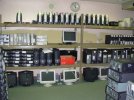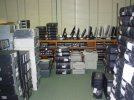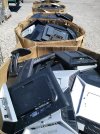The Ernie Ball company switched to Linux Terminal Server after Microsoft made an example of them in ads after what appears to be just sloppy accounting of repurposed machines (https://www.cnet.com/tech/tech-industry/rockin-on-without-microsoft/).I don't think any of the FOSS OS's are "ready-for-prime-time", enough, for that environment. School districts are woefully inadequate at supporting hardware and software products. You need something that is stripped down to the essentials; ONE supported filesystem, ONE desktop/window manager, ONE browser, ONE productivity suite, NO "extra tools/services", NO config files, etc. Everything has to "just work". This is contrary to most FOSS that seems to strive to be "most flexible" (even if you hide the configuration files, they still exist... the device can "change" because it has support for that change as part of its very nature).
I've been developing a STEAM curriculum to supplement the "mainstream" curriculum in elementary/jr high/high schools. The idea is to teach programming (concepts, not a specific LANGUAGE) with "real world" problems. Not silly abstractions ("Let's write a program to compute the Fibonacci sequence!").
To that end, I've been repurposing laptops to be "teaching appliances". Stripping everything out of the laptop that isn't essential to teaching the courseware and allowing students to develop solutions thereunder. You want to surf the web? Go find someone else's computer. You want to draw pictures? See previous comment. Etc.
Initially, we plan to teach students how to program a "robot" to navigate a maze. Force them to think about how THEY would navigate a maze IF THEY WERE IN THE MAZE (with only their immediate surroundings "probe-able"). Then, expose them to a pseudo-language (that runs in the laptop) to command a virtual robot to explore a maze depicted on the screen. They can see their code executing (single step) and watch what the on-screen robot is doing to discover the flaws in their aproach.
One can then offer different mazes to show them how various algorithms can fail. Eventually, getting them to refine their INDIVIDUAL solutions to the point where they can solve a "random" maze generated by their laptop to exercise their solution (and let them experience conditions that they might not have previously imagined -- what if the starting point is IN the maze instead of at the periphery?? Ooops!)
You can imagine how you can "evaluate" the efficiency of their algorithms -- count the number of "instruction fetches" to solve a particular maze; count the number of robot motions, etc. This inroduces the notion that algorithms have costs and some can be better than other -- even if they ALL solve the maze!
[You can see a more advanced class teaching students to maintain and update a model of the maze (based on their robot's observations) and infer characteristics of the maze based on that knowledge.]
As (technically) "supporting" such a curriculum can quickly get costly (time), you want to minimize the number of things that can go wrong with their kit. AND, make it easy to restore/replace their "defective" device with something to keep them "up" (i.e., let all of their "files" reside on a thumb drive; no way to "save" anything on the laptop/appliance, itself).
In one of the articles about Ernie Ball, it mentions that the users only have access to apps that they need. For example, if a person’s job is data entry, they don’t get a web browser, so they are not distracted by it. That idea might have application in academic organizations.






